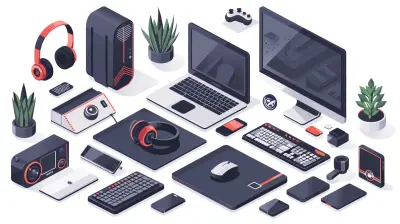How to Build a Seamless Mobile E-Commerce Experience
13 December 2024
With the rise of smartphones and mobile internet usage, it’s no surprise that mobile e-commerce is booming. Think about your own shopping habits. How often do you scroll through products on your phone while waiting in line, sitting on the couch, or even lying in bed? Exactly. We’ve entered an era where customers expect a flawless, fast, and easy-to-navigate mobile shopping experience.
But here’s the thing: building a seamless mobile e-commerce experience isn’t just about having a functional app. It goes way beyond that. You need to create an engaging, intuitive, and hassle-free journey for your users. After all, if your mobile site or app is clunky or slow, your potential customers are just a click away from abandoning their carts.
So, how can you build a mobile e-commerce experience that not only attracts users but also keeps them coming back for more? Let’s dive in!

Why Mobile E-Commerce Experience Matters
Before we get into the “how,” let’s talk about the “why.” Why should you care about optimizing for mobile? Well, the answer is simple: mobile commerce, or m-commerce, is the future of shopping. More than half of all web traffic now comes from mobile devices, and people are making more purchases from their phones than ever before. The way we shop has fundamentally changed.If your e-commerce platform doesn’t cater to mobile users, you’re leaving money on the table. A subpar mobile experience can lead to cart abandonment, lost sales, and frustrated customers. And trust me, no one wants that. In today’s hyper-competitive market, every little detail matters.
It’s all about convenience and speed. Your customers want to browse, add items to their carts, and check out with ease. If your mobile site or app is slow, cluttered, or difficult to navigate, that’s a one-way ticket to high bounce rates. And I bet you don’t want that.

1. Mobile-First Design: The Foundation of a Seamless Experience
Let’s start with the basics. If you’re serious about mobile e-commerce, you need to adopt a mobile-first design approach. This means designing your e-commerce platform specifically for mobile devices first, then scaling it up for desktop users.Why mobile-first? Because mobile screens are smaller, and that forces you to prioritize simplicity and usability. It’s like packing a suitcase for a weekend trip—you can only bring the essentials. A mobile-first design helps you focus on what’s truly important for your users and eliminates unnecessary clutter.
Here are some key tips to ensure your mobile-first design works:
- Keep it simple: Minimalism is your best friend. Avoid bombarding users with too many options or features on the home screen. Stick to the essentials—search, product categories, and cart.
- Responsive design: Make sure your website automatically adjusts to different screen sizes. This isn’t optional—users expect a smooth experience whether they’re on a smartphone, tablet, or desktop.
- Touch-friendly navigation: Ensure that buttons, icons, and menus are large enough to tap without frustration. Nobody wants to zoom in to click a button or accidentally hit the wrong one.

2. Speed is Everything: Optimize for Fast Load Times
Patience isn’t exactly a virtue in the world of mobile e-commerce. Your customers want instant gratification, and if your mobile site or app takes too long to load, they’ll bounce faster than a rubber ball. In fact, research shows that 53% of mobile users will abandon a site if it takes longer than three seconds to load. Ouch, right?So, what can you do to speed things up?
- Optimize images: High-quality images are essential for e-commerce, but they can also be a major culprit in slow load times. Compress your images without sacrificing quality.
- Use lazy loading: This technique ensures that images and other content only load when they’re about to appear on the user’s screen. This can significantly reduce initial load times.
- Minimize code: Streamline your website’s code to ensure it's as efficient as possible. This means cleaning up unnecessary JavaScript, CSS, and HTML.
- Consider a content delivery network (CDN): A CDN can help distribute your content across multiple servers worldwide, reducing load times for users no matter where they are.

3. Simplify the Checkout Process: Less Friction, More Conversions
Let’s be honest—checkout is where the magic happens. Or, at least, it should be. But if your checkout process is complicated or time-consuming, you’re practically begging customers to abandon their carts.Here’s the deal: the simpler the checkout process, the better. Your goal is to remove as much friction as possible. Think of it like a waterslide; the fewer bumps and turns, the faster and smoother the ride.
Here are some tips to streamline the checkout experience:
- Allow guest checkout: Forcing users to create an account before making a purchase is a surefire way to lose them. Give them the option to check out as guests to speed things up.
- Auto-fill forms: Mobile users don’t want to spend time typing out their address, credit card info, and other details. Use auto-fill features to make this process faster.
- One-click payments: If possible, integrate one-click payment options like Apple Pay, Google Pay, or PayPal. These methods are fast, secure, and already familiar to users.
- Progress indicators: Let your customers know how many steps are left in the checkout process. This helps set expectations and reduces the likelihood of them abandoning halfway through.
4. Prioritize Security: Build Trust with Your Customers
Trust is crucial when it comes to e-commerce—especially mobile e-commerce. Your customers are handing over sensitive information, like credit card numbers and personal addresses, so it’s essential that they feel safe and secure while doing so.Here’s how you can build trust through mobile security:
- SSL encryption: Ensure your site has an SSL certificate. This encrypts data between the user’s device and your servers, keeping sensitive information safe from prying eyes.
- Visible security badges: Display security badges and certifications prominently during the checkout process. This provides reassurance that your platform is legitimate and trustworthy.
- Two-factor authentication (2FA): Offer 2FA as an added layer of security for user accounts. This involves sending a verification code to the user’s phone or email, adding an extra step to prevent unauthorized access.
5. Personalization: Make It Feel Unique to Each Customer
Ever walk into a store and feel like the staff knows exactly what you're looking for? That’s the kind of experience you should aim to replicate with your mobile e-commerce platform. Personalization is key to making your customers feel special and understood.Here’s how you can add personalization to your mobile experience:
- Tailored product recommendations: Use data from previous purchases or browsing history to suggest products that your customers might be interested in. This not only enhances the user experience but also increases your chances of making a sale.
- Push notifications: Send personalized push notifications to remind users of items left in their cart or to let them know about sales and discounts that align with their preferences. But don’t overdo it—too many notifications can be annoying.
- Personalized search results: When users search for products, show them results based on their past behavior or preferences. For example, if they’ve been searching for running shoes, make sure those types of products appear at the top of their search results.
6. Leverage Reviews and Social Proof
Let’s face it: we trust recommendations from other people more than we trust brands. That’s why user reviews and social proof are so powerful in e-commerce. A well-placed review can be the deciding factor between a purchase and an abandoned cart.Here’s how to use reviews and social proof effectively:
- Showcase user reviews: Display product reviews prominently on your mobile site or app. Make sure users can easily see what others have said about a product before making a purchase.
- Incorporate star ratings: Star ratings provide a quick visual representation of how popular or well-received a product is. Users can make quicker decisions when they can see at a glance how a product is rated.
- Use customer photos: Allow customers to upload pictures of themselves using your products. This adds a personal touch and helps potential buyers visualize how the product might look in real life.
7. Test, Optimize, and Iterate
Building a seamless mobile e-commerce experience isn’t a one-time job. It requires constant monitoring and optimization. Trends change, user behavior evolves, and new technologies emerge. What works today might not work tomorrow, so you need to stay on your toes.Here’s how to make sure you’re always improving the mobile experience:
- A/B testing: Run A/B tests on different elements of your mobile site or app, such as buttons, layouts, or product images. This helps you figure out what resonates best with your audience.
- Analyze user behavior: Use tools like Google Analytics or heatmaps to see how users are interacting with your mobile platform. Are they getting stuck at certain points? Are there pages with high bounce rates? Use this data to make informed improvements.
- Collect feedback: Don’t be afraid to ask your customers for feedback. What did they love about their experience? What could be improved? Their insights will be invaluable as you continue to fine-tune your platform.
Final Thoughts: Putting It All Together
Creating a seamless mobile e-commerce experience is no small feat, but the rewards are well worth the effort. From mobile-first design and speedy load times to streamlined checkout and personalized recommendations, every detail matters when it comes to keeping your customers happy on their mobile devices.Remember, the mobile experience is an extension of your brand. It should be intuitive, engaging, and friction-free. So, invest in the right tools, stay on top of trends, and never stop optimizing. Your customers—and your bottom line—will thank you for it.
all images in this post were generated using AI tools
Category:
E CommerceAuthor:

Adeline Taylor
Discussion
rate this article
18 comments
Avianna Simon
Great insights! Creating a seamless mobile e-commerce experience is essential in today’s shopping landscape. I love how you highlighted user-friendly design and quick load times—those small details can make a huge difference for shoppers on the go!
March 20, 2025 at 3:23 AM

Adeline Taylor
Thank you! I’m glad you found the insights valuable. User-friendly design and fast load times are indeed key to enhancing the mobile shopping experience!
Caleb Warren
Great insights! Focusing on user-friendly design and fast load times is essential for creating an effective mobile e-commerce experience. Thanks for sharing!
February 26, 2025 at 5:28 AM

Adeline Taylor
Thank you! I’m glad you found the insights valuable. User experience is indeed key in mobile e-commerce!
Tatianna Sharpe
What a fantastic read! 🌟 This article brilliantly breaks down the essentials of creating a seamless mobile e-commerce experience. From user-friendly design to quick loading times, every tip is a gem! Can’t wait to implement these strategies and watch my sales soar! Happy selling, everyone! 📱💖
February 9, 2025 at 9:32 PM

Adeline Taylor
Thank you so much for your kind words! I'm thrilled you found the article helpful. Best of luck implementing the strategies—happy selling! 🌟📱
Selina Maddox
Build it right, or watch your sales take flight… away from you! In today's mobile-first world, a clunky experience is so last season. Step it up, or get left behind, darling!
January 31, 2025 at 4:52 AM

Adeline Taylor
Absolutely! A seamless mobile experience is crucial for retaining customers and boosting sales. Let’s prioritize user-friendly designs to stay ahead!
Jackson Pope
Great insights! Optimizing mobile experiences is crucial for boosting customer engagement and sales effectively.
January 25, 2025 at 9:38 PM

Adeline Taylor
Thank you! I completely agree—optimized mobile experiences are key to enhancing engagement and driving sales.
Falkor Ruiz
Great tips! Can't wait to implement these!
January 17, 2025 at 4:47 AM

Adeline Taylor
Thank you! Excited for you to try them out!
Natalia Spencer
Oh sure, just sprinkle some magic tech fairy dust and voilà—instant mobile e-commerce success! Who knew it was that easy? 🙄✨
January 6, 2025 at 11:32 AM

Adeline Taylor
I appreciate your sarcasm! Building a successful mobile e-commerce experience takes strategy and effort, not just fairy dust. ✨
Rune Carter
Great insights! Creating a seamless mobile e-commerce experience is crucial for today's shoppers. Excited to see how these tips can elevate our approach!
December 30, 2024 at 1:00 PM

Adeline Taylor
Thank you! I'm glad you found the insights valuable. Excited for you to implement the tips!
Faenor Hill
Building a seamless mobile e-commerce experience is like crafting a perfect avocado toast: a sprinkle of innovation, a dash of user-friendly design, and just the right amount of tech spice! Remember, if users can swipe right on your app, they'll be craving more than just breakfast! 🥑📱✨
December 25, 2024 at 1:36 PM

Adeline Taylor
Absolutely! Just like a perfect avocado toast, a seamless mobile e-commerce experience requires the right blend of elements to keep users engaged and coming back for more.
Charlotte Rivera
Great insights for mobile success!
December 23, 2024 at 9:25 PM

Adeline Taylor
Thank you! I'm glad you found the insights valuable!
Carter McCullough
If you’re not prioritizing a seamless mobile e-commerce experience, you’re setting your business up for failure. Today’s shoppers demand perfection—anything less is unacceptable. Embrace innovation, simplify navigation, and make every interaction count. Your success depends on it.
December 21, 2024 at 5:57 AM

Adeline Taylor
Absolutely agree! A seamless mobile experience is crucial for meeting shopper expectations and driving sales. Prioritizing innovation and user-friendly navigation is key to success in today’s competitive market.
Morrow McMillan
Empower your customers with effortless shopping!
December 18, 2024 at 8:23 PM

Adeline Taylor
Absolutely! Empowering customers through a seamless mobile experience enhances convenience and boosts satisfaction.
Foster Long
Great insights! Crafting a seamless mobile e-commerce experience is like creating a smooth dance—every step matters. Remember, the goal is to make shopping fun and easy for everyone. Let's keep dancing toward those sales! 💃📱✨
December 16, 2024 at 4:18 AM

Adeline Taylor
Thank you! I love the dance analogy—every detail does count in creating an enjoyable mobile shopping experience! 💃📱✨
Soraya McWain
Prioritize speed and user-friendly design for success.
December 14, 2024 at 1:52 PM

Adeline Taylor
Absolutely! Speed and user-friendly design are essential for engaging users and driving conversions in mobile e-commerce.
Cruz Brown
Great insights on enhancing mobile e-commerce! Your tips emphasize the importance of user experience and accessibility. As mobile shopping continues to grow, these strategies will undoubtedly help businesses connect better with customers. Excited to see how these practices evolve and impact the e-commerce landscape. Keep up the great work!
December 14, 2024 at 4:50 AM

Adeline Taylor
Thank you for your kind words! I'm glad you found the insights helpful. Excited to see how the mobile e-commerce landscape evolves!
Faenor McAuley
Absolutely loved this article! 🌟 The tips for creating a seamless mobile e-commerce experience are spot on! It’s exciting to see how technology can enhance shopping. Can’t wait to implement these ideas and elevate my store! 🛍️📱
December 13, 2024 at 9:11 PM

Adeline Taylor
Thank you so much for your kind words! I'm thrilled you found the tips helpful and exciting for your store! Happy implementing! 🌟🛍️
Eden Rosales
Great insights! Excited to see how innovative design and technology can truly enhance mobile shopping journeys for users.
December 13, 2024 at 11:39 AM

Adeline Taylor
Thank you! I’m excited too—innovation will definitely reshape mobile shopping for the better!
Melissa McCoy
Great article! A seamless mobile e-commerce experience is crucial for success. Focusing on user-friendly design, fast loading times, and secure payment options can significantly enhance customer satisfaction and boost sales. Excited to see more insights like this!
December 13, 2024 at 4:05 AM

Adeline Taylor
Thank you for your feedback! I’m glad you found the article helpful. Stay tuned for more insights!
MORE POSTS

Building Your First Web App with React

Understanding Drone Flight Modes and When to Use Them

The Evolution of Machine Learning in Search Engine Algorithms

Optimizing Your Software for Performance: A Developer’s Guide

Are True Wireless Earbuds Worth the Hype?

Content Creation on the Go: Mobile Apps You Can’t Miss

How 5G is Driving Innovation in the Automotive Industry

Exploring the Future of AI in Digital Assistants

Integrating Digital Assistants with Home Automation Systems

The Future of Peripherals: How AI is Changing Computer Accessories

G and the Future of Wearable Technology